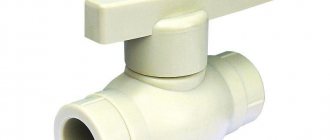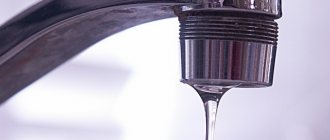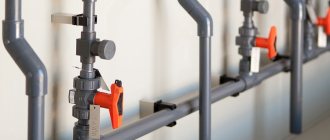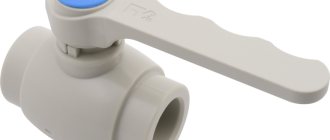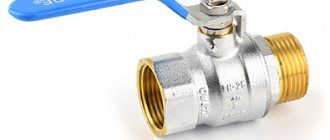Posted by PlumberResolution | Category: Articles |
Published: 09/22/2020
A ball valve is a type of shut-off valve equipped with a spherical-shaped locking part. It has a through hole to open and block the flow of liquid.
Ball valves have a simple design, provide complete tightness when blocking the flow and are easy to operate. They are widely used for autonomous water supply to private houses and in households for supplying and shutting off the flow of water and gas. If such fittings are installed in your home, it will not hurt to understand how it works, as well as to know in what position the water ball valve is open or closed
Types of valves
To determine the position of the device and find out how the valve opens or closes, you first need to know the type of device installed.
In household systems the following are most often installed:
- ball valves. There is a metal ball in the body of the device, which serves as a locking mechanism. The body and locking element are usually made of durable metals (brass, steel, bronze), which ensures a long period of use of the device;
Valve with ball-shaped locking mechanism
- plug valves. The locking elements in this type of device are cylindrical or conical plugs. The plug valve body is also made of high-strength metal. The locking mechanism allows the valve to be used in pipelines with aggressive media.
Valve with cylindrical plug
. plug valve
Anyone else have plug valves on their old various piping systems or gas lines. A particularly pressing question is in what position should the plug valve be open or closed if there is no handle on it (Photo 11). So, usually at the top of the end of the rod (plug), even during manufacturing, a slot (notch) is made to visually determine the through hole in the plug (Fig. 1).
As in the case of ball valves, if the slot in the position across (perpendicular) to the plug valve is closed, the slot along (parallel) is open.
The ball valve has a handle. It is designed either in the form of a long rod or in the form of a “butterfly”), that is, a nut with flat wings. If the tap is open, then the handle (or wings) are directed along the axis of the pipe, as if along the flow of water. If the tap is closed, then the handle is turned perpendicular to the axis of the pipe, blocking the flow. This is how it should be standard.
And God forbid, someone will put the handle differently). We had a case when testing an installation - on the inlet ball valve the handle was in reverse. So we ran around this installation for about 5 hours, we couldn’t understand why the hell the pumps with regulators weren’t pumping)), if the tap was clearly open).
Opening and closing valves
You can determine whether a valve is open or closed by several criteria, depending on the type of device installed.
Determining Ball Valve Position
To determine the state of the ball valve, you can use:
- control handle;
- recess located on the rod.
The ball valve can be equipped with two types of handles:
- a handle, which is an oblong element attached to the body of the device;
- a butterfly handle, consisting of two similar parts, located symmetrically relative to the attachment point.
The valve closes if the handle is turned perpendicular to the device and the direction of the pipeline, and opens if the handle is turned in the direction of the axis of the device and, accordingly, the pipeline.
. ball valve
A ball valve (ball valve) has in its design either a handle (handle) or a butterfly handle. The position of the handle axis determines whether the mechanism is closed or open. If the axis of the handle is parallel to the axis of the tap and the pipe on which it stands, then it is open (Photo 1). And if the axis of the handle is perpendicular (at an angle of 90 degrees) to the axis of the ball valve, then it is closed (Photo 2). And the protrusions on the body limit rotation to a certain angle for the convenience of maximum opening - “counterclockwise” or closing - “clockwise”.
People often forget in what position they have an angle ball valve installed on a water supply, for example, for a washing machine (Photos 5 and 6).
Sometimes it happens that the handle is broken or missing, and how do you understand what position the ball-type mechanism is in? By the groove(s) on the stem (Photo 7) you can recognize the position of the valve by analogy, as with the handles (Photo 8).
Types of valves
To determine the position of the device and find out how the valve opens or closes, you first need to know the type of device installed.
In household systems the following are most often installed:
- ball valves. There is a metal ball in the body of the device, which serves as a locking mechanism. The body and locking element are usually made of durable metals (brass, steel, bronze), which ensures a long period of use of the device;
Methods for regulating water pressure
To protect communications from water hammer, stable operation of household appliances and plumbing, it is necessary to maintain standard water pressure in the system. This task is performed by gearboxes.
Most manufacturers produce designs with a preset pressure setting not exceeding 3 bar. But, if you wish, you can configure it yourself.
Adjustment is made exclusively with the taps closed by rotating the adjusting head. To increase the pressure, it must be rotated to the right, and to reduce the pressure, rotation is performed in the opposite direction.
One turn of the adjusting knob changes the pressure by 0.5 bar.
When a pressure gauge is installed in the system, the adjustment is carried out quite accurately, and where there is no pressure gauge, the result can be visually assessed by the force of pressure from the mixer.
In a private house, the pressure in the water supply system is maintained using a hydraulic accumulator and a pressure switch. These products are included with ready-made pumping stations, but you can install the system yourself. Adjustment of the relay in the desired range is carried out by adjusting the large and small springs, according to the manufacturer's instructions.
Opening and closing valves
You can determine whether a valve is open or closed by several criteria, depending on the type of device installed.
Determining Ball Valve Position
To determine the state of the ball valve, you can use:
- control handle;
- recess located on the rod.
The ball valve can be equipped with two types of handles:
- a handle, which is an oblong element attached to the body of the device;
- a butterfly handle, consisting of two similar parts, located symmetrically relative to the attachment point.
The valve closes if the handle is turned perpendicular to the device and the direction of the pipeline, and opens if the handle is turned in the direction of the axis of the device and, accordingly, the pipeline.
Determining the valve status by the handle installed on the device
The following video will help you determine the condition of the valve by looking at the handle.
If the handles are broken or completely missing for some reason, is it possible to find out the position of the valve? To determine the condition of the device under the circumstances under consideration, you can use the groove located on the rod.
Element by which the valve position can be determined
If the recess is located parallel to the pipeline, then the valve is open and allows liquid (gas) to pass through. If the recess is located perpendicular to the direction of the pipes, then the valve is closed and the movement of liquid through the system is impossible.
Determining valve position by groove
The right approach and expert advice
First, let me emphasize that this article will consider household valves and other water supply control systems, which in most cases are used in an apartment or private house. Products that are used on a gas cylinder belong to a slightly different category. But some of the recommendations below may be useful for them as well.
Disassembly procedure
- For example, it is best to consider the design that is used in the kitchen . The fact is that it has more parts and in most cases is fixed using special fasteners. It can only be compared to a bathroom sink faucet, which is very similar in design.
- First of all, craftsmen advise removing the handles on the taps . To do this, on some models you will need to remove the decorative plugs, and on other systems you will need to remove the pin and remove the handle.
- Most of the manuals explaining how to unscrew a rusty faucet at the next stage advise using a special tool or wrapping it in rags . The fact is that if it comes off or accidentally hits the structure, it can cause important damage that spoils the appearance.
- Craftsmen who say that I can’t unscrew the valve axlebox are first advised to choose the right tool and try with the valve open . At the same time, there is no need to allow distortions or displacements. The tool must be firmly fixed to the surface of the part.
- The installation instructions recommend removing the faucet in the next step . But its chrome-plated nuts must be unscrewed extremely carefully so as not to damage the coating.
- The mixer itself is removed only after the water supply pipes have been disconnected from the system . Along with this, it is necessary to unscrew the fixing bolt or nut that holds the pressure plate. This must be done very carefully, because the price of the sink is quite high, and there is a high chance of accidentally damaging it during this work.
Advice! If the gasket on the axle box is being replaced, the part must be unscrewed very carefully so as not to loosen the mixer itself. In another case, you will need to change the rubber seal on the sink.
Problematic points
Most of the manuals explaining how to unscrew a stuck faucet are confident that such a problem can be solved quite simply and with the right approach it can be eliminated in a couple of minutes. To do this, it is enough to treat the joints with a special compound, and if necessary, it is poured into the cavity of the structure itself.
While it is impossible to remove the axle box if it is stuck, in most cases they look at the material of its manufacture. Along with this, if this part is made of simple metal, like the sink faucet itself, then experts advise making a complete replacement of the entire structure, because, most likely, this part cannot be unscrewed due to rust.
It is worth using different compounds on an axle box or tap, if it is stuck, only in those cases when it is impossible to mechanically unscrew the product. Along with this, if this happens systematically, then you need to think about the quality of the water used and buy a filter.
Advice! Various oils, acidic compounds and alkaline solutions are excellent for removing scale, but their effectiveness is highly questionable, especially if the density of the blockage is quite large.
Expert advice
- If the work is done with your own hands, then it is best to first familiarize yourself with the design of a specific crane model. In most cases, it is outlined in detail in the management that comes with it.
- It’s worth preparing all the necessary tools in advance, because similar work may require additional keys, screwdrivers, etc.
- It is worth emphasizing that virtually all designs of such products are of the same type, despite the fact that they can have a lot of differences. Based on this, the question of how to unscrew a dark tap in a gas boiler can also be attributed to this situation and similar control can be applied.

